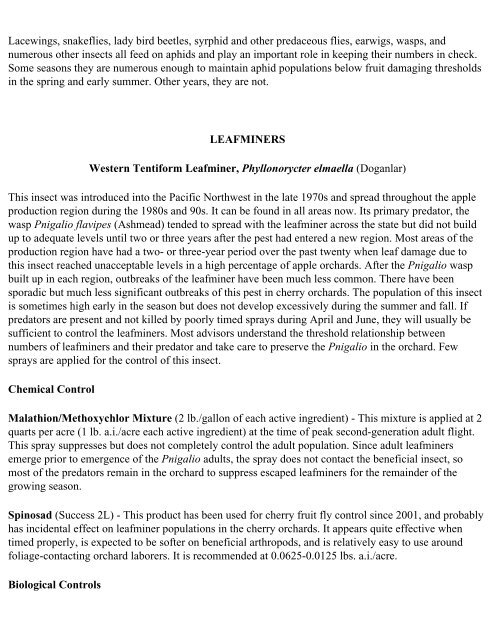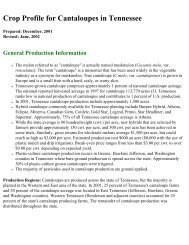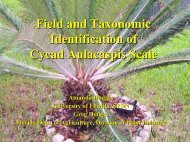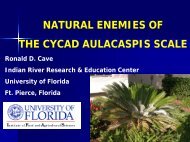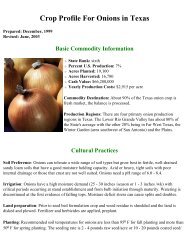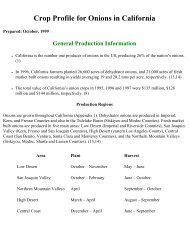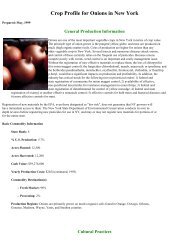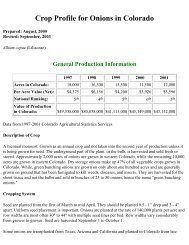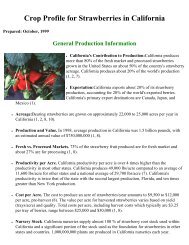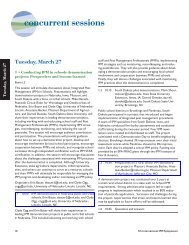Crop Profile for Cherries (Sweet) - Regional IPM Centers
Crop Profile for Cherries (Sweet) - Regional IPM Centers
Crop Profile for Cherries (Sweet) - Regional IPM Centers
Create successful ePaper yourself
Turn your PDF publications into a flip-book with our unique Google optimized e-Paper software.
Lacewings, snakeflies, lady bird beetles, syrphid and other predaceous flies, earwigs, wasps, and<br />
numerous other insects all feed on aphids and play an important role in keeping their numbers in check.<br />
Some seasons they are numerous enough to maintain aphid populations below fruit damaging thresholds<br />
in the spring and early summer. Other years, they are not.<br />
LEAFMINERS<br />
Western Tenti<strong>for</strong>m Leafminer, Phyllonorycter elmaella (Doganlar)<br />
This insect was introduced into the Pacific Northwest in the late 1970s and spread throughout the apple<br />
production region during the 1980s and 90s. It can be found in all areas now. Its primary predator, the<br />
wasp Pnigalio flavipes (Ashmead) tended to spread with the leafminer across the state but did not build<br />
up to adequate levels until two or three years after the pest had entered a new region. Most areas of the<br />
production region have had a two- or three-year period over the past twenty when leaf damage due to<br />
this insect reached unacceptable levels in a high percentage of apple orchards. After the Pnigalio wasp<br />
built up in each region, outbreaks of the leafminer have been much less common. There have been<br />
sporadic but much less significant outbreaks of this pest in cherry orchards. The population of this insect<br />
is sometimes high early in the season but does not develop excessively during the summer and fall. If<br />
predators are present and not killed by poorly timed sprays during April and June, they will usually be<br />
sufficient to control the leafminers. Most advisors understand the threshold relationship between<br />
numbers of leafminers and their predator and take care to preserve the Pnigalio in the orchard. Few<br />
sprays are applied <strong>for</strong> the control of this insect.<br />
Chemical Control<br />
Malathion/Methoxychlor Mixture (2 lb./gallon of each active ingredient) - This mixture is applied at 2<br />
quarts per acre (1 lb. a.i./acre each active ingredient) at the time of peak second-generation adult flight.<br />
This spray suppresses but does not completely control the adult population. Since adult leafminers<br />
emerge prior to emergence of the Pnigalio adults, the spray does not contact the beneficial insect, so<br />
most of the predators remain in the orchard to suppress escaped leafminers <strong>for</strong> the remainder of the<br />
growing season.<br />
Spinosad (Success 2L) - This product has been used <strong>for</strong> cherry fruit fly control since 2001, and probably<br />
has incidental effect on leafminer populations in the cherry orchards. It appears quite effective when<br />
timed properly, is expected to be softer on beneficial arthropods, and is relatively easy to use around<br />
foliage-contacting orchard laborers. It is recommended at 0.0625-0.0125 lbs. a.i./acre.<br />
Biological Controls


